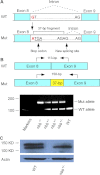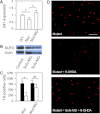Functional expression of SCL/TAL1 interrupting locus (Stil) protects retinal dopaminergic cells from neurotoxin-induced degeneration
- PMID: 23166330
- PMCID: PMC3543037
- DOI: 10.1074/jbc.M112.417089
Functional expression of SCL/TAL1 interrupting locus (Stil) protects retinal dopaminergic cells from neurotoxin-induced degeneration
Abstract
We previously isolated a dominant mutation, night blindness b (nbb), which causes a late onset of retinal dopaminergic cell degeneration in zebrafish. In this study, we cloned the zebrafish nbb locus. Sequencing results revealed that nbb is a homolog of the vertebrate SCL/TAL1 interrupting locus (Stil). The Stil gene has been shown to play important roles in the regulation of vertebrate embryonic neural development and human cancer cell proliferation. In this study, we demonstrate that functional expression of Stil is also required for neural survival. In zebrafish, decreased expression of Stil resulted in increased toxic susceptibility of retinal dopaminergic cells to 6-hydroxydopamine. Increases in Stil-mediated Shh signaling transduction (i.e. by knocking down the Shh repressor Sufu) prevented dopaminergic cell death induced by neurotoxic insult. The data suggest that the oncogene Stil also plays important roles in neural protection.
Figures







Similar articles
-
STIL: a multi-function protein required for dopaminergic neural proliferation, protection, and regeneration.Cell Death Discov. 2019 Apr 25;5:90. doi: 10.1038/s41420-019-0172-8. eCollection 2019. Cell Death Discov. 2019. PMID: 31044090 Free PMC article.
-
Transcription of the SCL/TAL1 interrupting Locus (Stil) is required for cell proliferation in adult Zebrafish Retinas.J Biol Chem. 2014 Mar 7;289(10):6934-6940. doi: 10.1074/jbc.M113.506295. Epub 2014 Jan 27. J Biol Chem. 2014. PMID: 24469449 Free PMC article.
-
A novel function of the human oncogene Stil: Regulation of PC12 cell toxic susceptibility through the Shh pathway.Sci Rep. 2015 Nov 9;5:16513. doi: 10.1038/srep16513. Sci Rep. 2015. PMID: 26549353 Free PMC article.
-
Characterization of the human oncogene SCL/TAL1 interrupting locus (Stil) mediated Sonic hedgehog (Shh) signaling transduction in proliferating mammalian dopaminergic neurons.Biochem Biophys Res Commun. 2014 Jul 11;449(4):444-8. doi: 10.1016/j.bbrc.2014.05.048. Epub 2014 May 20. Biochem Biophys Res Commun. 2014. PMID: 24853807
-
The human oncogene SCL/TAL1 interrupting locus is required for mammalian dopaminergic cell proliferation through the Sonic hedgehog pathway.Cell Signal. 2014 Feb;26(2):306-12. doi: 10.1016/j.cellsig.2013.11.010. Epub 2013 Nov 12. Cell Signal. 2014. PMID: 24240054
Cited by
-
STIL: a multi-function protein required for dopaminergic neural proliferation, protection, and regeneration.Cell Death Discov. 2019 Apr 25;5:90. doi: 10.1038/s41420-019-0172-8. eCollection 2019. Cell Death Discov. 2019. PMID: 31044090 Free PMC article.
-
Transcription of the SCL/TAL1 interrupting Locus (Stil) is required for cell proliferation in adult Zebrafish Retinas.J Biol Chem. 2014 Mar 7;289(10):6934-6940. doi: 10.1074/jbc.M113.506295. Epub 2014 Jan 27. J Biol Chem. 2014. PMID: 24469449 Free PMC article.
-
A novel function of the human oncogene Stil: Regulation of PC12 cell toxic susceptibility through the Shh pathway.Sci Rep. 2015 Nov 9;5:16513. doi: 10.1038/srep16513. Sci Rep. 2015. PMID: 26549353 Free PMC article.
-
Sensory Integration: Cross-Modal Communication Between the Olfactory and Visual Systems in Zebrafish.Chem Senses. 2019 Jul 17;44(6):351-356. doi: 10.1093/chemse/bjz022. Chem Senses. 2019. PMID: 31066902 Free PMC article. Review.
-
Neurodegeneration, Neuroprotection and Regeneration in the Zebrafish Retina.Cells. 2021 Mar 12;10(3):633. doi: 10.3390/cells10030633. Cells. 2021. PMID: 33809186 Free PMC article. Review.
References
Publication types
MeSH terms
Substances
Grants and funding
LinkOut - more resources
Full Text Sources
Other Literature Sources
Molecular Biology Databases
Research Materials
Miscellaneous

